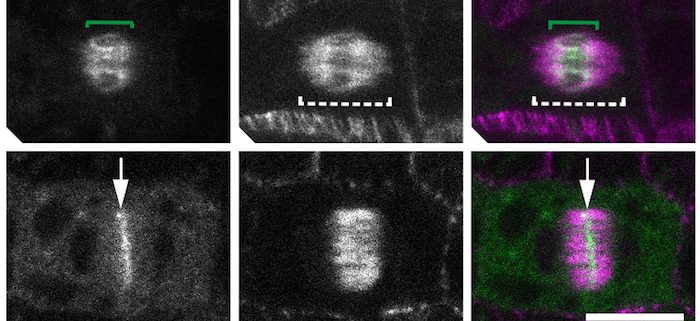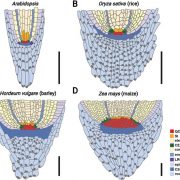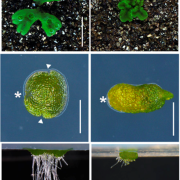How Plant Cells Shape Spindles during Division
Herrmann et al. uncover the role of KINESIN-12E in the rapid alignment of chromosomes during cell division. The Plant Cell (2020) https://bit.ly/3lCfIzf
By Arvid Herrmann
Howards Hughes Medical Institute at University of Texas at Austin, Sabine Müller, Center for Plant Molecular Biology, University of Tübingen
Background: Cell division is the process by which a parent cell produces two daughter cells. To ensure that the genetic materials, the chromosomes, are partitioned equally, the dividing cell uses the spindle. The spindle is a cellular structure made of proteins that assemble into filaments. When division starts, these filaments, known as microtubules, directly connect with the chromosomes to arrange them in the cell center. Afterwards, the filaments shrink, pulling the chromosomes apart. It is important for the organism that cell division proceeds accurately and rapidly. Therefore, so-called motor-proteins or kinesins help organize the microtubules properly in order to form the spindle, connect with chromosomes, and finally separate the latter. In animals, kinesin-12 helps fulfill these functions.
Question: We wanted to know whether kinesin-12 in plants also functions in spindle organization. However, unlike animals, which contain only one kinesin-12, most plants possess several. Among the functionally characterized plant kinesin-12 proteins, none has a role in spindle organization.
Findings: Of the six Arabidopsis kinesin-12 proteins, we focused our analysis on kinesin-12E, the closest relative of animal kinesin-12. We fused a fluorescent protein with kinesin-12E and observed the fluorescent signal throughout cell division using microscopy. When cell division started, the signal appeared on microtubules that sorted and reorganized to form the spindle and connect with chromosomes. Once the chromosomes had lined up in the division plane, the kinesin-12E signal was confined around and between the two sets of opposing chromosomes, which later separated. To investigate the function of kinesin-12E, we examined mutants and found that in the absence of kinesin-12E, the organization of the spindle was slower and spindles were smaller compared to wild type. Intriguingly, a smaller spindle was observed in animal mutants as well.
Next steps: We will test directly whether animal kinesin-12 and plant kinesin-12E indeed share similar functions in spindle organization. This will help us understand the similarities and differences in animal and plant spindle organization. Our findings also raise crucial questions about the evolution of the plant kinesin-12 family and its functional diversification.
Arvid Herrmann, Pantelis Livanos, Steffi Zimmermann, Kenneth Berendzen, Leander Rohr, Elisabeth Lipka, Sabine Müller (2021). KINESIN-12E regulates metaphase spindle flux and helps control spindle size in Arabidopsis. Plant Cell https://bit.ly/3lCfIzf










